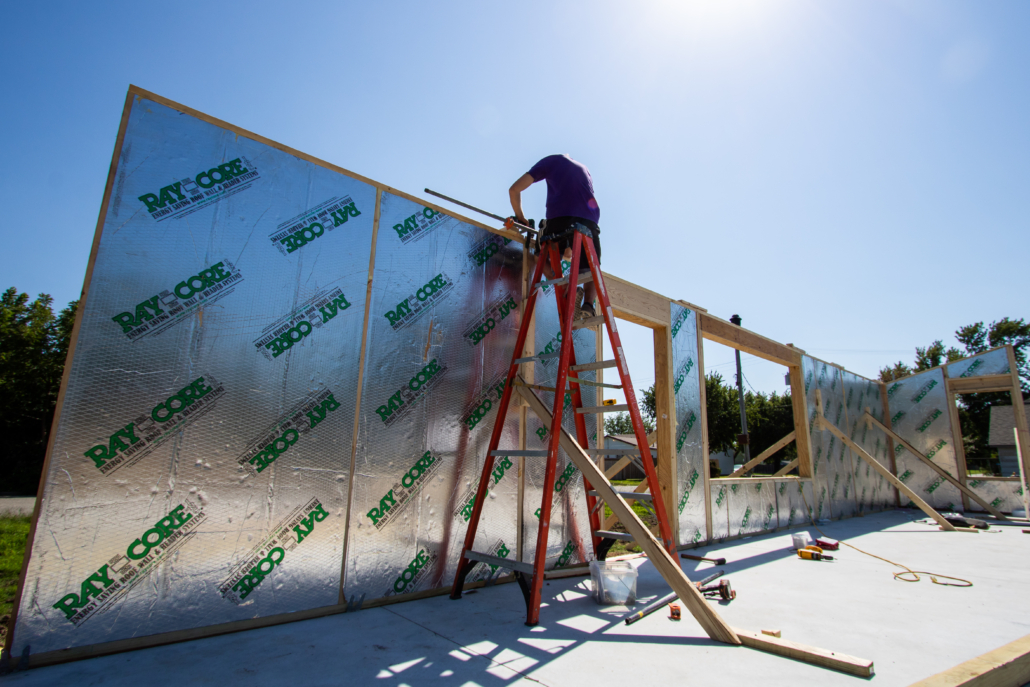There are solutions to the rural Kansas housing crisis
By Elizabeth Baker for St. John News published August 16, 2020
A member of the KSU Dept. of Architecture team secures two wall panels together at the Net+ home at 8th and Broadway in St. John.
Photo by Elizabeth Baker
ST. JOHN, KS— With all its intricacies and individualism, St. John, Kansas offers residents a unique way of life in south-central Kansas. Yet, St. John is similar to most towns across America in one core way: its struggle for adequate affordable housing.
A lack of affordable housing is found in almost every corner of the United States, be it in populated metropolitan areas or small, rural towns. Despite a strong focus and success rate of economic development measures, St. John is not exempt from this fight for enough safe, affordable, and stable housing for residents.
The issue of affordable housing looks drastically different across the United States and the realities of this issue vary in different communities. Most simply put, a home is affordable if mortgage or rent payments, as well as taxes and basic utilities, do not exceed 30% of a household’s gross income. ( source )
The rising cost of living, coupled with a stagnant minimum wage, has made affordable housing even less accessible. The National Low Income Housing Coalition (NLIHC) estimates that one in every four renter households across the United States has extremely low income and cannot afford the rent.
In Kansas, the minimum wage is equivalent to the federal minimum wage: $7.25 per hour. The NLIHC lists the necessary salary to afford average rent in Kansas at more than double that amount at a wage of at least $15.59 per hour.
In St. John, the median household income is a bit over $43,000, a full $13,000 less than the state average. Almost 1,200 residents reside full-time in St. John, boasting a median age of 36.2 years old.
When affordable housing is discussed, the focus tends to be on bigger cities with large populations of houseless people. While society is in tune with the ways in which rural areas are impacted by economic decline, affordable housing is still often left out of these conversations.
Affordable housing is a keystone piece of maintaining small-town communities. In smaller towns, the effects of unaffordable housing on middle-class residents in addition to lower-income populations is even more apparent.
Efforts to aid the affordable housing crisis often look at other factors that may affect a person’s ability to find and maintain housing. For example, the “Housing First” approach to homelessness posits the simple fact that housing is a necessary first step to improving one’s position in life. Such models are guided by the understanding that basic necessities, such as shelter and food, must come prior to any other needs such as finding stable employment or addressing mental or behavioral health issues.
Rural affordable housing efforts specifically are intertwined with the USDA program Section 515. This program subsidizes the construction of affordable rural homes for rent via construction cost and landlord assistance. Section 515 has created over 28,000 rural and affordable properties across the United States since 1963.
Affordable housing efforts also commonly bring understanding to how housing intersects with broader community development goals. The necessity for such understanding becomes especially important in small, rural towns such as St. John.
Carolyn Dunn, Director of Stafford County Economic Development, discusses the work that her organization does for affordable housing, balancing “the idea of how affordable housing intersects with effective overall community development.” Dunn highlights the need to “sustain schools and essential social services that make a community a community” in discussing affordable housing.
The Stafford County Economic Development team has made community development a focus since its founding and affordable housing continues to be an aspect of this focus. As society continues to understand the varying facets of the affordable housing crisis, rural towns such as St. John will continue to tackle social issues with perseverance, practical solutions, and an optimistic outlook for the years ahead.




